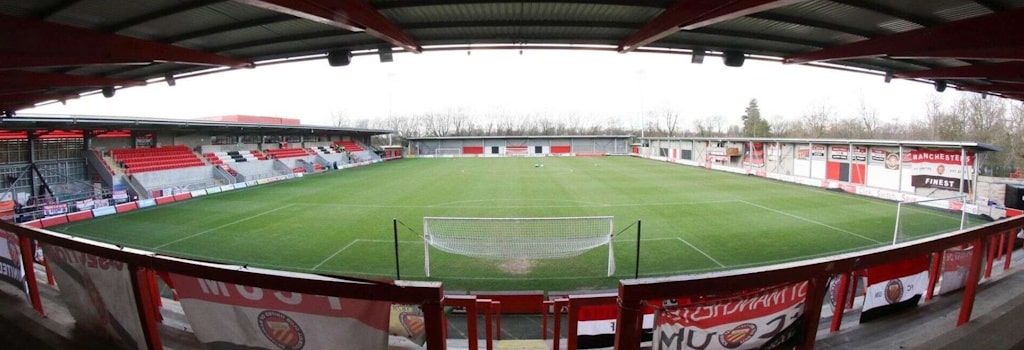

Put yourself in the picture: You're on a crumbling terrace at Dulwich Hamlet on a Tuesday evening, wedged alongside 2,000 passionate supporters bellowing songs they've bellowed for years. Compare that with Arsenal's Emirates Stadium, where 60,000 spectators sit in seats with room to spare, often checking their phones while corporate hospitality guests sip champagne in glass boxes above.
Which of the two, you reckon, sounds more alive? To be honest, it's probably going to be the former. And that is exactly the problem Premier League clubs face; they've lost nothing in terms of revenue and facilities but something far more precious: their soul.
You get a feeling immediately when you're at a non-league ground: the atmosphere is never made up. There is no stadium announcer desperately trying to get everyone up with "Make some noise!" chants. Instead, you'll hear songs spontaneously occurring that emerge from the crowd themselves, typically referencing local derby games, club heroes, or in-jokes that have accumulated over the years.
At FC United of Manchester (not to confuse it with Manchester United), average attendance is about 2,500, but the noise levels consistently top what you would get at Premier League stadiums, with 20 times the capacity. Why? Because of the natural crowd dynamics of standing terraces, the seated spaces just can't match. When supporters are able to move, surge up onto the terraces for attacks, and physiologically express themselves, the atmosphere becomes contagious.
Premier League teams have tried to replicate that with "safe standing" zones, but they're typically too cramped or too controlled to generate the same informal mood. You're witnessing sanitized emotion rather than experiencing raw emotion.
It's here that the difference really is stark. Non-league players tend to reside in the same areas as their supporters, go shopping in the same supermarkets, and drink in the same pub. You could find yourself standing alongside your center-half in the local coffee shop on a Monday morning.
This instills responsibility that is completely missing in modern Premier League football. If a player makes £200,000 a week and lives in a gated mansion 30 miles from the stadium, there is little or no identification with the community they are meant to represent.
But it's not just about the footballers. Non-league clubs are genuine community centers. The club room is open after the game, hosting everything from kids' birthday parties to business meetings for local firms. Place that against Premier League stadiums, which are ghost towns the instant the final whistle goes.
The traditional betting culture at non-league grounds tells its own story about the authentic football experience. You'll still find local bookmakers setting up near the turnstiles, offering odds on everything from the first goalscorer to which player gets booked first. This face-to-face betting culture fosters its own social dynamic, with fans debating odds, sharing tips, and celebrating wins together. It's a far cry from the isolated experience of mobile betting apps that dominate Premier League matchdays, where supporters are more likely to be scrolling through kinghills sister sites comparing odds than engaging with fellow fans about their predictions.
Step into Wembley and you are dwarfed by the occasion. Step into a non-league stadium, and you feel like you're part of something close to home. The distinction is more important than you realize.
At Conference level and below, you're normally close enough to eavesdrop on players' chat, pick up their facial gestures, and be really connected to the play. There is no massive screen telling you when to clap or corporate sponsors covering every surface you can see.
This human touch extends to price, too. While Premier League season tickets can cost between £2,000+ per annum, the majority of non-league clubs are selling season tickets for under £200. That's not just about price; it's about being affordable enough for entire families, creating the next generation of genuine supporters, and not weekend fans.
The irony is that Premier League clubs spend millions on fan engagement programs but have deliberately removed most of what builds genuine fan loyalty. They've priced out locals, moved to soulless out-of-town stadiums, and created matchday environments that are more about being corporate experiences than football matches.
Some clubs are finally realizing it. Liverpool's Anfield retains more vitality than most Premier League grounds simply because it's held on to its Kop terrace ethos despite seating orders. But these are rare instances.
The issue isn't just economic. It's intellectual. Can the clubs operating as global brands actually reconnect with local communities? Can corporate hospitality grounds ever replicate the immediacy of old grounds?
You don't need to ditch Premier League football altogether, but you should give non-league football a go to understand what has been lost. The intensity, authenticity, and community sense that is at the grassroots level is actually the soul of football, something that money or advertising cannot reproduce.
Premier League clubs may have much to learn from these small stadiums, not in facilities or finance, but in their understanding of what makes football great. At the end of the day, football is not about how nice the corporate boxes are or how high the HD screens are; it's about the connection between club and people, player and fan, and the shared experience of being part of something more than yourself.
That's a valuable lesson, no matter what league you play in.
Tony Incenzo has been to over 2,000 football grounds - is he the world's barmiest football fan? Read about his love for Non-League football and groundhopping obsession, including watching a match in prison!
23 interesting things to do to pass the time until the football season restarts
Taking my son to his first football match was one of the best experiences I've had as a father so far. I've written this article for Alex to read when he gets older.
An in-depth look at the biggest football attendances ever recorded, from the 1950 World Cup to pre-season friendlies in the States and the Scottish ground with dozens of 100,000+ attendances
